Special guest blog by Jeanne Whitehurst, English Egyptologist living in Aswan
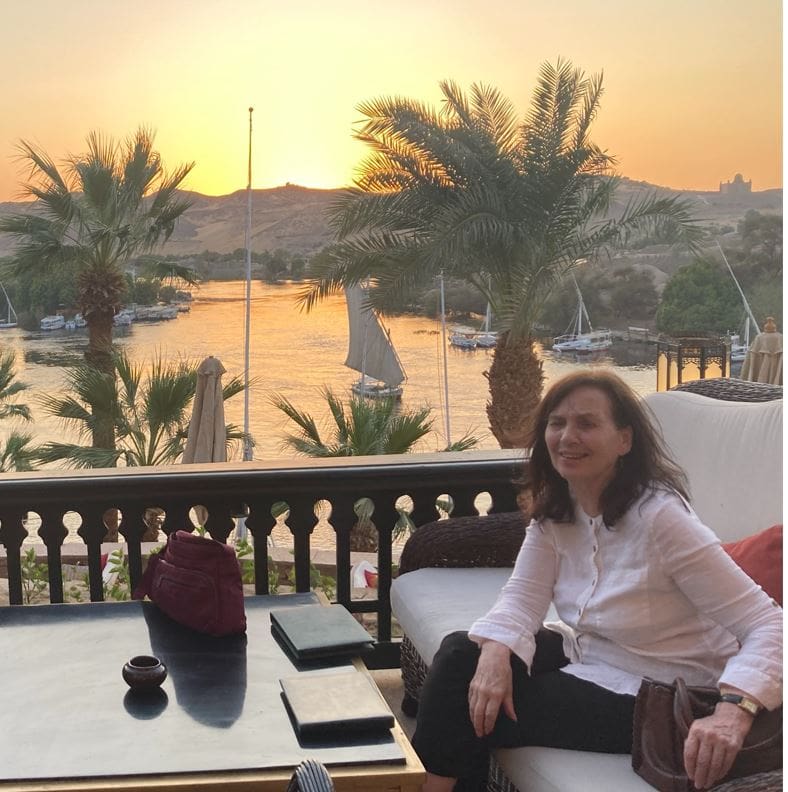
Temples were built for over 3,500 years in Ancient Egypt, the earliest, mostly, open courts sun temples to the sun god Re while the last one to be built was the cult Temple to Isis at Philae in Aswan. Most Ancient Egyptian temples that have survived are from the Greco Roman period, such as, Esna, Edfu, Kom Ombo, Dendera and Philae but we also have many temples from other periods, especially in Southern Egypt due to the drier climate.

Dendera Temple: Magnificent Hypostyle Hall
Reasons for Egyptian Temples
In hieroglyphs a temple translates into the house or mansion of the god but they also performed a deeper mythological reason which we can see either in the name of the temple or the surrounding area, re-creating the primordial mound where the cosmic egg was laid and all life started, this is represented by the ground of the temple rising gradually to recreate this, the holy of holies being at the highest point, all the decoration around also emphasis the beginning of the world, stars on the ceiling; for example, the barque chapel of Alexander and Philip Arrhidaeus at Karnak temple, many plants are around the base, including the Hypostyle Halls and other halls representing the marshes. Within them, the priests performed a variety of rituals, giving offerings to the gods, reenacting their mythological interactions through festivals, and warding off forces of chaos. These rituals were necessary for the gods to continue to uphold “maat”, the divine order of the universe.
Egyptian temples were houses for the gods or kings to whom they were dedicated. Within them, the Egyptians performed a variety of rituals, the central functions of Egyptian religion: giving offerings to the gods, reenacting their mythological interactions through festivals, and warding off the forces of chaos. These rituals were seen as necessary for the gods to continue to uphold maat, the divine order of the universe. Housing and caring for the gods were the obligations of pharaohs, who therefore dedicated prodigious resources to temple construction.
The temple is also an interface between earth and heaven, between the world of the living and divine. Pylons represent the horizon, akhet, in which the sun would rise between the pylons, a good example of this is the Winter Solstice at Karnak, where the sun rises directly between the pylons on the main axis on this date.

A lot of thought went into building the temple, selecting the area, often based on myth and tradition, like the Temple of Dendera which was built on an original Middle Kingdom temple. The god’s birthplace, such as Abydos, the cult temple of Osiris, the mythical first king, where first and second dynasty kings were buried, the Ancient Egyptians reasoned that one of the tombs must have belonged to Osiris. It could also be just for practical reasons, near to a settlement often in line with The Nile running East to West or North to South and lastly, stellar alignment, Thoth Hill is a good example, where two temples were built , first, the Archaic and then a Middle Kingdom temple, the outline of the temples are slightly different, Egyptologists have concluded the reason for this is because the stars changing alignment during the intervening time.
Foundation Rituals
The ancient Egyptian equivalent of our groundbreaking ceremony were the “foundation rituals” which conferred the protection of the gods on the building works and the finished building. There are ten different rituals, the first and probably the best known with many different examples is “stretching the cord” overseen by the goddess Seshet,(goddess of writing and measurement and the ruler of books) The “cord” in question is the mason’s line which was used to measure out the dimensions of the building and align the building with the stars or the points of the compass, they would mark the four corners of the building at night to align with the stars, stretch the cord, driving the stakes into the ground and loosening the cord, marking the limit of the building.
Next, came hoeing the ground, where the pharaoh would dig the first foundation with a wooden hoe, representing the upper limit of the waters of Nun. This was followed by the moulding of the first brick, made of mudbrick, with the pharaoh’s name one it, Howard Carter replicated this at his house on the West Bank of Luxor; having a brick made in England with his initials engraved on it.
The fourth element the pouring of the sand, first by the pharaoh and then the workman would fill in the trenches to make the foundations, next came the burying of the deposits in a mudbrick lined ditch, it would consist of model tools plus other symbolic items such a baskets, jewellery etc. next was the actual construction and the final parts were purifying the temple and dedicating it to the deities.
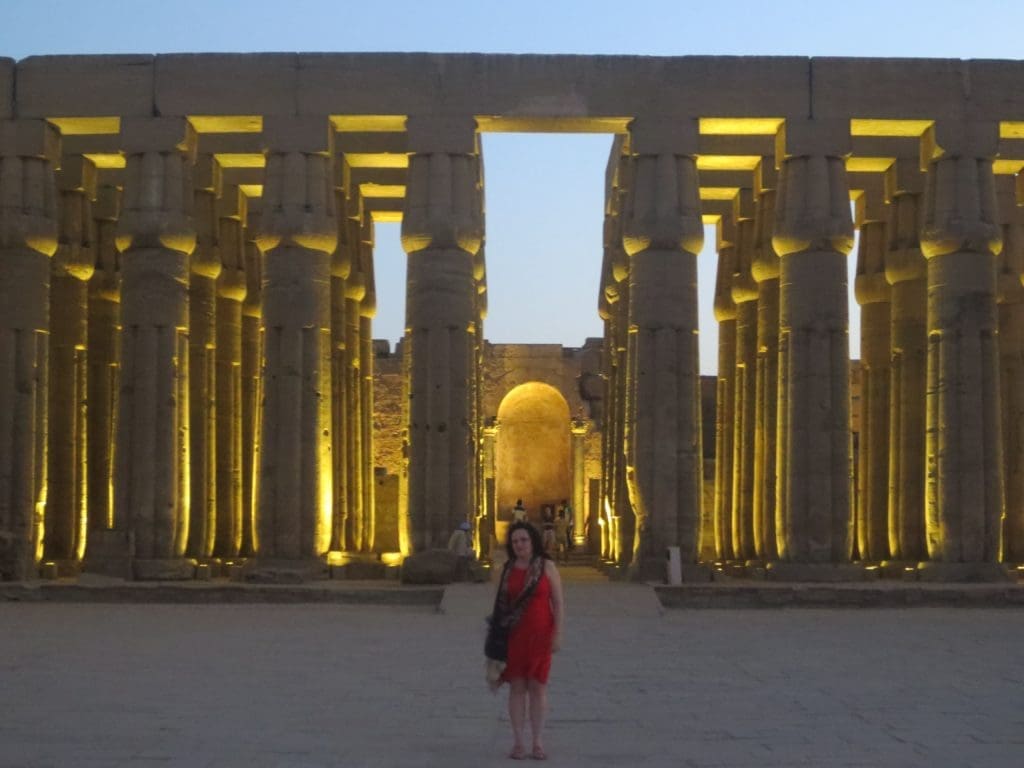
Luxor Temple at Night
Temple construction
Early temples were built of mudbrick which was gradually replaced by stone, entirely built by stone by the New Kingdom, mostly, sandstone, but also limestone, granite or basalt. The sandstone from the New Kingdom onwards was quarried from Gebel el Silsila, an amazing site between Edfu and Kom Ombo. The building of the temple was either by a mudbrick ramp, for example, behind the first pylon at Karnak, by Nectanebo, a pharaoh from the 30th dynasty or by wooden scaffolding as seen on an 19th dynasty ostraca from Deir el Medina, now in Hildesheim museum or depicted in the tomb of Rekhmire(TT 100). Egyptians today, when building use the same type of wooden scaffolding and like the Ancient Egyptians build on poor foundations!
After being built with the stone, it was then smoothed from top to bottom. Other temple structures outside the temple included the landing quay and the avenue of sphinxes, for protection. Inside, the sacred lake, where the god may bath, the priests would be ritually cleaned, also the temple utensils washed, the nilometer, a flight of steps with marks on the walls which would indicate the height of the Nile in the Inundation, obelisks, to the sun god Re with a pyramidion at the top covered in electron, a mixture of gold and silver to welcome the first rays of the sun.
Workman worked in gangs with each having a specific job, outlining the image, filling in the image etc., you can see many examples where the depiction wasn’t finished ,such as the rekhyt bird freize from the Temple of Dendera at Qena where the central bird decoration isn’t completed. N.B Dr Ken Griffin is an expert on the rekhyt bird therefore I am loath to make any comment on them. Basically, from the outer part, there is a pylon, open courts; from the New Kingdom, a hypostyle hall and the most sacred part, the sanctuary, where the god resided, around the outside was an enclosure wall made of mudbrick, it was “wavy”, which either represented the waters of Nun or from an engineering point of view, it would be stronger to withstand earthquakes.

Avenue of the Sphinxes
Decorating the temple
The temples were carved in either raised (bas relief) or sunken relief(incising). The Naos and the holy of holies were usually carved in bas relief, while the open parts accessible to the public and outside walls were in sunken relief, the sun reflects on the carvings giving them depth, it would then be painted. Columns are part of the construction but also part of the decoration and representing the cosmos as marshes, at Saqqara there are bundles of reeds represented, then palmiform or papyriform in the New Kingdom temples, there is even tent pole columns found in the Tutmosis III temple at Karnak, in the Greco-Roman period they become multi-floral.

Progression of temples
Pre-dynastic, ( 3100-2649 BCE) the early temples were a quite simple design with a small number of anti-chambers before the sanctuary. Reeds or mudbrick were the materials of these early temples. An example is Hierakonpolis, at the city of the vulture goddess, Nekhen, near present day Esna, to the god Horus, excavators have found the holes where the large wooden flagpoles made of sycamore fig would have stood, there was a gateway to the North , a shrine to the south with a large sand mound in the middle.
Old Kingdom Temples, (2649-2150 BCE) there were three types of temple in the Old Kingdom, cult, mortuary and both cult and mortuary, an example of the latter are the fifth dynasty sun temples to the sun god Re, (the first state god), at Abu Ghurab, North of Abu Sir on the West Bank where the first six of the 5th dynasty pharaohs had mortuary sun temples built there, there are only two remaining now, Userkaf and Niuserre, the latter being in the best condition. The Ancient Egyptians thought Re (the sun) died at night and needed to be resurrected each morning by the priests, fortunately we have the Abu Sir papyrus which gives details of these rituals. Re’s main cult centre was at Heliopolis near to present-day Cairo Airport.
Middle Kingdom Temples, (2061-1690 BCE) , would originally be made of mudbrick and in time would be replaced by stone, initially, door jambs and lintels. There are also very few remains, one example is Medamud, to the north of Luxor, with its Avenue of Sphinxes, to the local god of war, Montu. Also, Medinet Mardi in the Fayoum built in the twelve dynasty. The reason we have so few remaining is because succeeding pharaohs used them as infills or in their own temples, a good example of this is the Twelve dynasty temple on the West Bank at Luxor which was built by Montuhotep II, Hatshepsut reused these blocks to erect her own mortuary temple at Deir el Bahri next to his on the Northern side. However, the White chapel, a way station, in the open air museum at Karnak, built in the reign of Senwosret I, was reconstructed from the third pylon infill from the reign of Amenhotep III, 951blocks were found and excavators were able to reconstruct this chapel, it shows high quality in carving and symmetry. The way station was a resting place for the priests carrying the god in his or her barque from one temple to another, there would be steps leading up to the dais and steps leading down.

Amenhotep Temple
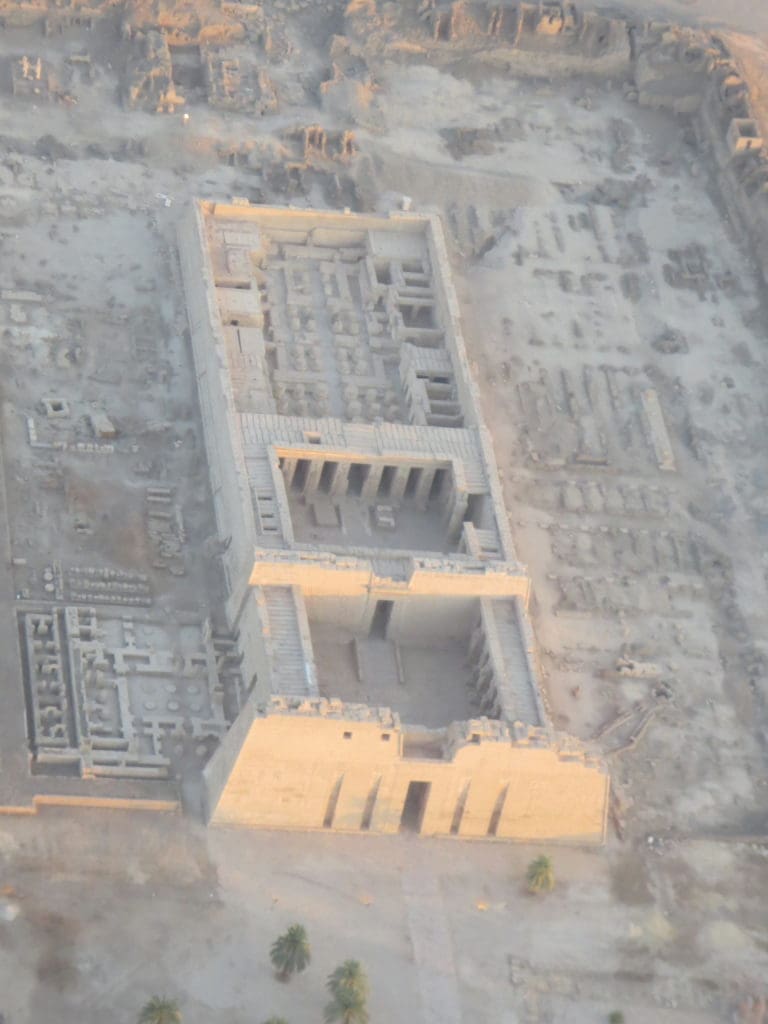
Medinet Hebu from above
New Kingdom Temples, (1549-1077)there was an explosion of temples built at this time, especially around Luxor, as Luxor, ancient Thebes had become the religious capital. This was the “golden age”of the Egyptian empire, especially in the reign of Amenhotep III and Rameses II. The pharaohs often tried to outdo the previous pharaoh, usually their father, and wrote such epithets as “never had the like been seen before!” They replaced other pharaoh’s names with their own. The largest temple is the cult temple at Karnak which covers 247 acres and has over twenty chapels and temples within its boundary walls, the great main temple to Amun is built along an East ,West axis, while the Mut temple to his wife is north to south.
The hypostyle hall is a feature of New Kingdom temples, two, in the case of Luxor Temple but the most majestic must be the one at Karnak, started by Seti I and continued by his son Rameses II, two rows of columns, twelve in all, line the central nave, their height, 20 metres with shaped capitals representing papyrus stalks in bloom. To either side of these, two adjoining rows of smaller columns which hold the clerestory windows to allow in some light as the roof would have covered the columns. There are one hundred and twenty-two of these shorter columns, the capitals representing closed papyrus flowers, each measuring 14 metres, supported the lower roof.
The New Kingdom temples have depictions of pharaohs quelling and smiting the enemies of Egypt, hunting scenes and the king riding his chariot, all showing the might of Egypt and especially the pharaoh and to show the king maintaining maat,! These are to be found on the outside walls or in the peristyle halls, the pharaoh’s children may be depicted here as seen in Luxor temple, these are the son’s of Rameses II, all are before the hypostyle hall where the religious rituals are shown and of course the sanctuary. Also seen, throughout the temple scenes of the pharaoh offering to the gods.
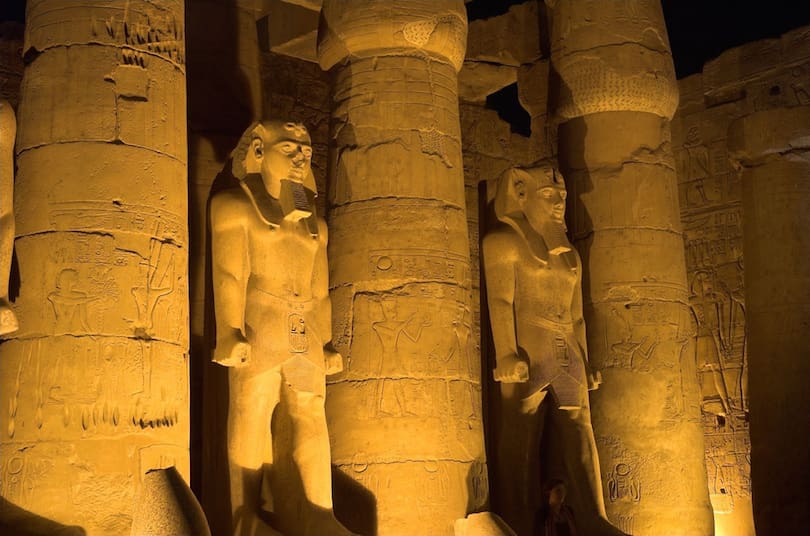
Luxor Temple

Seti Temple
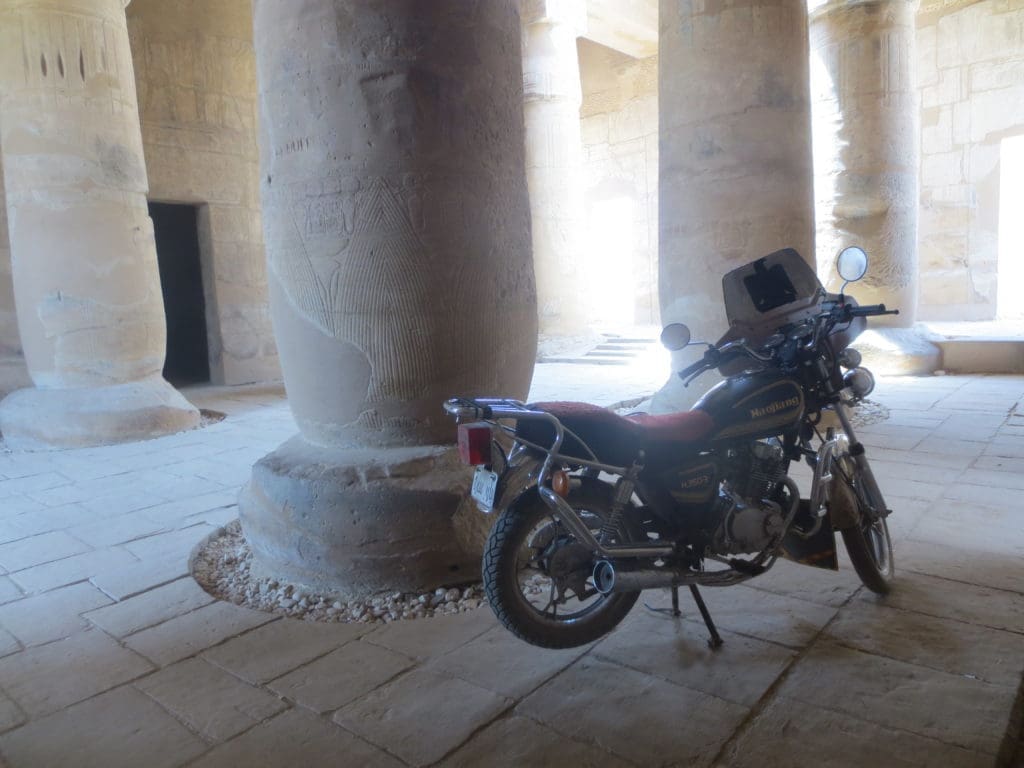
Temple of Seti I Hypostyle Hall
Amarna Temples, ( in Middle Egypt, El Minya) there were radical changes during the reign of the pharaoh Akhenaten as the main god was Aten, a form of the sun god, the temple reverted to the open plan sun courts, in the case of the great temple at Amarna there was the addition of two stone buildings, one at the front, the long temple and the sanctuary at the rear. There was a raised platform in the outer court where Akhenaten and his family would offer prayers and offerings to the Aten, Unusually, there are scenes of everyday life in these temples.
Greco-Roman Temples, (332-30 BCE) the architecture remains virtually the same with some additions. Kom Ombo is unusual as it is a double temple to the gods Sobek and Haroeris (Horus the Elder) and split into two different sides, each one mirroring the other. Philae is another example, as it is built on an island, its architectural plan following the terrain. The Mamessi or birth house, where the divine birth of the deity was reborn, and the juvenile god was celebrated in the form of a mystery play. They are found outside the temple but to the side of the courtyard and topped with the god Bes for protection.
The wabet ( pure hall) was an important addition with its open courtyard and elevated position which was associated with the New Year’s festival, where basically the statue of the deity would be brought from its place, either in the crypt or the sanctuary and taken to the wabet where prayers would be recited, it would then be taken up the nearby stairs to the roof chapel where various rituals would be performed. Screen walls are found in Greco-Roman temples these are walls built just under half way between the columns, they are to stop the ordinary person from seeing in, but allows in light, usually to the pro naos, which is in front of the hypostyle hall, its function was to act as a reception area for the visiting deities, representing unifying Egypt. Finally, the cult terraces where the deity could be seen, or they could greet other visiting deities. For the ordinary person at the back of the temple would have been an image of the god, where they could have brought offerings or made a plea to the god.
Visiting Egyptian temples has a special magic, everyone has a favourite, I have a few but I would like to tell you more about Karnak Temple from my personal view of living there. I lived near to “the red mound” and the chapel of the hearing ear on the East Side of the temple, wonderful to see the sun setting over the temple but not as wonderful hearing “the sound and light” in all the different languages. One of the treats was eating dates from the temple complex itself, making them very special.
My friend lives on the Westside, she has married an Egyptian whose family have worked in the temple for generations, they actually lived in the temple itself at one time, their “new” flat, still has a wonderful view of the temple from her roof. The temple has many moods during the day, the colours of the various temples change and at night it has a mystical form from the subdued lights and the moon. Knowing many locals who live around the temple, overlooking the Temple of Mut, the 9th pylon and the different gigantic gateways, you get different perspectives of this great temple complex from these different areas. I have even walked all around the perimeter! Perhaps, the most magical experience was having the temple to myself for 3 hours during the revolution, walking through the hypostyle hall, sitting admiring the views from different perspectives, looking closely at hieroglyphs was a once in a lifetime experience. Temples are a reminder of the extraordinary ability to build by the architects and craftsmen of ancient Egypt. We are privileged to visit all these temples.

